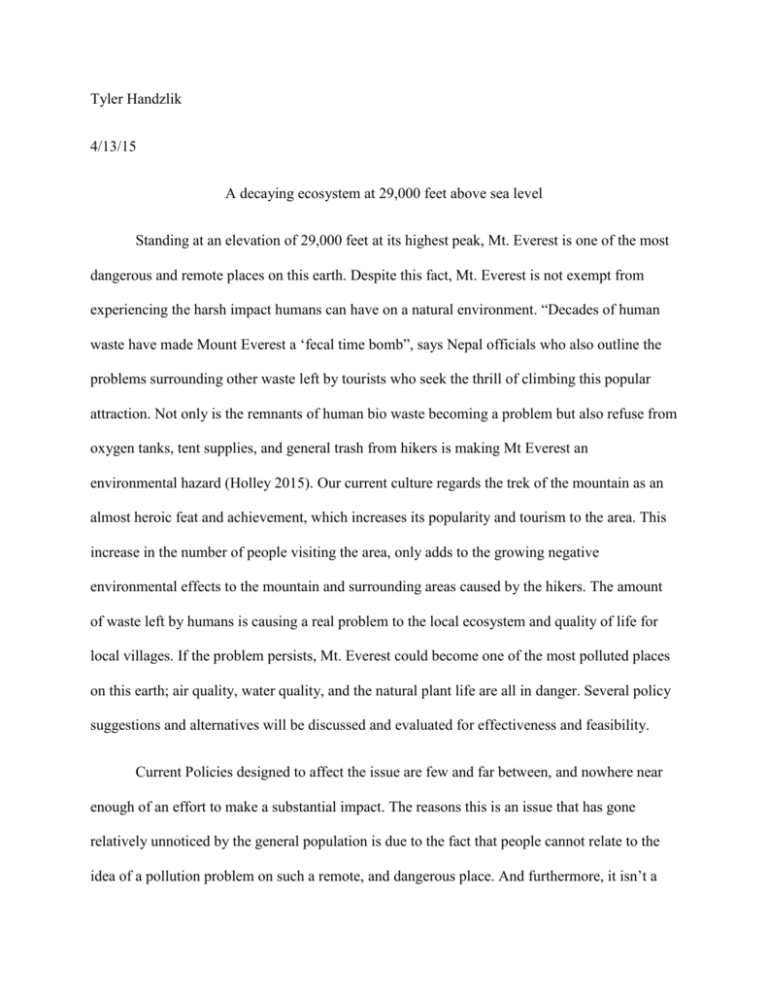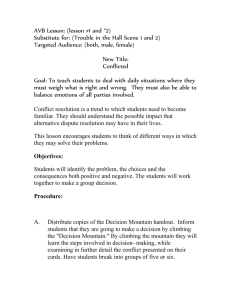A Decaying Ecosystem at 29000 Feet above Sea Level
advertisement

Tyler Handzlik 4/13/15 A decaying ecosystem at 29,000 feet above sea level Standing at an elevation of 29,000 feet at its highest peak, Mt. Everest is one of the most dangerous and remote places on this earth. Despite this fact, Mt. Everest is not exempt from experiencing the harsh impact humans can have on a natural environment. “Decades of human waste have made Mount Everest a ‘fecal time bomb”, says Nepal officials who also outline the problems surrounding other waste left by tourists who seek the thrill of climbing this popular attraction. Not only is the remnants of human bio waste becoming a problem but also refuse from oxygen tanks, tent supplies, and general trash from hikers is making Mt Everest an environmental hazard (Holley 2015). Our current culture regards the trek of the mountain as an almost heroic feat and achievement, which increases its popularity and tourism to the area. This increase in the number of people visiting the area, only adds to the growing negative environmental effects to the mountain and surrounding areas caused by the hikers. The amount of waste left by humans is causing a real problem to the local ecosystem and quality of life for local villages. If the problem persists, Mt. Everest could become one of the most polluted places on this earth; air quality, water quality, and the natural plant life are all in danger. Several policy suggestions and alternatives will be discussed and evaluated for effectiveness and feasibility. Current Policies designed to affect the issue are few and far between, and nowhere near enough of an effort to make a substantial impact. The reasons this is an issue that has gone relatively unnoticed by the general population is due to the fact that people cannot relate to the idea of a pollution problem on such a remote, and dangerous place. And furthermore, it isn’t a problem that has been reported widely by very many major news outlets. Only recently have their begun major cleanup efforts and policy enactments to begin the slow process of eliminating decades of harm. It will take time in order for the tourism popularity to coincide with the general awareness of the environmental problems related to the hikers. While organizing cleanup efforts and enacting stricter tourism regulations for hikers may make the biggest impact to help save the ecosystem of the mountain, it may in fact be the least feasible due to the political circumstances inside the Nepali government. The Nepali government has had a history of being corrupt and inefficient, while also being associated with Maoist violence (Figueroa 2013).The type of government that would need to efficiently run the right type of operation to help with pollution control on Mt. Everest would need to be one that is free of corruption and influence from other parties. A combined effort from several nations seems to be the most efficient and feasible way a real cleanup effort can take place. Decades of human waste and garbage as well as the bodies of those who perished on their journey need to be removed. This task is no easy feat, and in order for it to be done correctly, the nations or even private groups who want to continue to use and preserve the mountain will find it in their best interest to help with the cleanup effort. In 2014, the Nepali government enacted a new law requiring every climber of the mountain to bring back eighteen pounds of garbage after their trek. This is the amount that is estimated that every climber will perhaps leave on the mountain if they do not bring it back and properly dispose of it. The strength of this policy initiative is that it works to cut down on any future waste left by humans upon the mountain. However, this strength is also its downfall because a rule such as this does little to help with the vast amount of waste and pollution that still exists on the mountain from years past. Furthermore, another weakness of this policy solution taken by the Nepali government is the punishment for those who do not come back with the required amount of garbage (Holley 2015). Those who do not comply void their $4,000 deposit to climb the mountain; however one of the issues with this is the impact of vanity as described by Pablo Figueroa of Waseda University. Figueroa explains that recently, one of the main problems that exemplify the pollution problem is the mindset many hikers have when seeking to reach the top of the mountain. The majorities of hikers see the trek as a selfish achievement and look at the mission as one that is not dependent upon money. Therefore, making any type of punishment that involves the use of fiscal penalties will see to be ineffective. These hikers only care about fulfilling their sometimes “lifelong” goal of getting to the top and will do it in the way that is most comfortable to them, which may mean leaving behind waste and garbage. In addition, each trek can cost any individual upwards of $30,000 so forfeiting a $4,000 deposit may seem worth it for some risk seeking individuals who do not properly know of the hazards that they may cause. Currently, the majority of human waste is carried down from Mt. Everest from workers and taken to the nearby village “Gorak Shep” where the waste is dumped in pits and stored. The problem with this is the fact that this is only a temporary solution to a more serious problem. What is beginning to happen is that the village is running out of space to hold the waste and these storage areas are even beginning to contaminate water sources of nearby villages. An example of a new policy that can be implemented to improve this situation could be a program that uses the human waste and turns it into a positive for local villages. As outlined by Rachel Nuwer, a “biogas reactor” project has been started by Garry Porter. Porter is an engineer and climber from Seattle who witnessed the problem first hand when he climbed the mountain himself and saw what kind of impact the human waste had on local villages and the potential future complications with the natural environment. The biogas reactor project will work much like those that are in use on farms across the globe. These reactors use bacteria to feed on organic waste which produces several gases that can be used as a power source. While the biogas fuel byproducts will help the local villages produce electricity, Porter hopes it will also help the native plant species on Everest. Hikers of the mountain also need resources to cook food, and get warmth which many hikers receive from the local plant life and one of them is an endangered species, the alpine juniper (Nuwer 2013). Allowing hikers to now use this biogas byproduct as a cooking source and heat source can help the mountain plant habitat as well. Although this policy idea is a great solution to do something with the human excrement, there still needs to be new policies to address how the waste gets to this reactor to create any sort of benefit. Despite the efforts to encourage climbers to properly dispose and carry their waste, there are still those who do not follow these rules and resort to leaving behind their waste on the mountain. Combine this with the hundreds of tons of waste left by hikers in years past and this waste can still cause some serious ecological hazards to the mountain and surrounding areas. Those with the Everest Summiteers Association reiterated to CNN that every expedition is “required” to take a garbage deposit and bring their waste back; however the issue is this policy has not been strictly carried out. In order to have a policy such as this be effective there needs to be a strong overseeing force to make sure expeditions comply otherwise they have no incentive to do so. The problem with this is that the Nepal government is very reluctant to enforce strict tourism regulations due to the fact they rely heavily on the money generated from the large number of groups who look to ascend the mountain. Therefore, the solution to help to save the mountain environment and clean up the pollution cannot involve anything that may decrease the number of tourists. As explained by Ed Viesturs, an accomplished mountaineer, “Everest has been degraded by its sheer popularity. Let’s not degrade it further.” Mt. Everest was never meant to be inhabited by humans at the rate it is today. The impacts the humans are making on the mountain are leaving it in a vulnerable and fragile state. The popularity of the achievement and vanity of reaching the top of the mountain is what can be the ultimate downfall of the mountain environment, unless we change the way we think about this quest. Our current culture suggests it is almost a heroic achievement, and one that is looked upon with great admiration. This is in fact the root of the problem, once people begin to look past the selfish feat, and change how we glorify those who reach the top, will the mountain environment gradually improve (Figueroa 2013). Because changing the way people think is problematic and perhaps the least feasible from a policy perspective, one policy suggestion would be to implement an education program. Although the Nepal government may not comply due to the cost, having a class system set up for those before they climb the mountain to inform them of the impact that they have on the mountain environment may help to reduce the level of pollution by those in the future. I would suggest they use the deposits forfeited by the climbers who do not bring back the required amount of waste and garbage to fund the classes. In a more feasible approach, what may prove to be more effective would be too create more global awareness of the issue at hand. The money forfeited from the deposits of hikers can be used to get the word out all over the world by the use of social media and other media outlets. As time goes on more and more people will become aware of the problem which may in fact change the way our culture looks at Mt. Everest and those who choose to begin the journey to the top. If the majority of people on the earth begin to learn about the deteriorating ecological environment upon the mountain and surrounding areas, change will occur. Soon, other governments and private entities may make it more of a point to help in the cleanup effort, and take pressure off from Nepal to organize and fund these operations due to their political circumstances. Although the majority of people may never think twice at the possibility of Mt. Everest having a pollution problem, it is a very real problem, and one that is getting worse by each climber to venture up the mountain. The sheer popularity perpetuated by our culture is turning the mountain into a tourist hot spot that is not good for the local ecosystem and to those people who call it home. A number of ways can be looked into to help with the cleanup effort of Mt. Everest, but ultimately it comes down to whether or not enough support can be garnered in order to make a strong enough impact. The longer the current amount of trash and waste is left on the mountain the more harm is done to the local environment which has the ability to spread if not tended to properly. 1934 words Works Cited Figueroa, Pablo. "Vanity, Pollution and Death on Mt. Everest." Our World. United Nations University, 15 July 2013. Web. 16 Mar. 2015. <http://ourworld.unu.edu/en/vanitypollution-and-death-on-mt-everest>. Holley, Peter. "Decades of Human Waste Have Made Mount Everest a ‘fecal Time Bomb’." The Washington Post. 3 Mar. 2015. Web. 13 Mar. 2015. <http://www.washingtonpost.com/news/morning-mix/wp/2015/03/03/decades-of-humanwaste-have-made-mount-everest-a-fecal-time-bomb/>. Nuwer, Rachel. "Mount Everest Climbers’ Waste Could Power Local Villages." Smithsonian.com. 13 May 2013. Web. 16 Mar. 2015. <http://www.smithsonianmag.com/smart-news/mount-everest-climbers-waste-couldpower-local-villages-63923557/?no-ist>.






